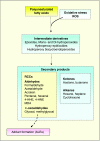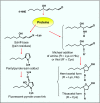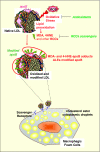Advanced lipid peroxidation end products in oxidative damage to proteins. Potential role in diseases and therapeutic prospects for the inhibitors
- PMID: 17643134
- PMCID: PMC2199390
- DOI: 10.1038/sj.bjp.0707395
Advanced lipid peroxidation end products in oxidative damage to proteins. Potential role in diseases and therapeutic prospects for the inhibitors
Abstract
Reactive carbonyl compounds (RCCs) formed during lipid peroxidation and sugar glycoxidation, namely Advanced lipid peroxidation end products (ALEs) and Advanced Glycation end products (AGEs), accumulate with ageing and oxidative stress-related diseases, such as atherosclerosis, diabetes or neurodegenerative diseases. RCCs induce the 'carbonyl stress' characterized by the formation of adducts and cross-links on proteins, which progressively leads to impaired protein function and damages in all tissues, and pathological consequences including cell dysfunction, inflammatory response and apoptosis. The prevention of carbonyl stress involves the use of free radical scavengers and antioxidants that prevent the generation of lipid peroxidation products, but are inefficient on pre-formed RCCs. Conversely, carbonyl scavengers prevent carbonyl stress by inhibiting the formation of protein cross-links. While a large variety of AGE inhibitors has been developed, only few carbonyl scavengers have been tested on ALE-mediated effects. This review summarizes the signalling properties of ALEs and ALE-precursors, their role in the pathogenesis of oxidative stress-associated diseases, and the different agents efficient in neutralizing ALEs effects in vitro and in vivo. The generation of drugs sharing both antioxidant and carbonyl scavenger properties represents a new therapeutic challenge in the treatment of carbonyl stress-associated diseases.
Figures





Similar articles
-
[New markers of advanced damage caused by oxidative and carbonyl stress].Sb Lek. 2001;102(4):465-72. Sb Lek. 2001. PMID: 12448197 Review. Czech.
-
Proatherogenic effects of 4-hydroxynonenal.Free Radic Biol Med. 2017 Oct;111:127-139. doi: 10.1016/j.freeradbiomed.2016.12.038. Epub 2016 Dec 29. Free Radic Biol Med. 2017. PMID: 28040472 Review.
-
Glycoxidation and lipoxidation in atherogenesis.Free Radic Biol Med. 2000 Jun 15;28(12):1708-16. doi: 10.1016/s0891-5849(00)00228-8. Free Radic Biol Med. 2000. PMID: 10946212 Review.
-
Oxidative Stress and Advanced Lipoxidation and Glycation End Products (ALEs and AGEs) in Aging and Age-Related Diseases.Oxid Med Cell Longev. 2019 Aug 14;2019:3085756. doi: 10.1155/2019/3085756. eCollection 2019. Oxid Med Cell Longev. 2019. PMID: 31485289 Free PMC article. Review.
-
Lipoxidation in cardiovascular diseases.Redox Biol. 2019 May;23:101119. doi: 10.1016/j.redox.2019.101119. Epub 2019 Feb 25. Redox Biol. 2019. PMID: 30833142 Free PMC article. Review.
Cited by
-
Detoxification of aldehydes by histidine-containing dipeptides: from chemistry to clinical implications.Chem Biol Interact. 2013 Feb 25;202(1-3):288-97. doi: 10.1016/j.cbi.2012.12.017. Epub 2013 Jan 9. Chem Biol Interact. 2013. PMID: 23313711 Free PMC article.
-
Cardiac and vascular phenotypes in the apolipoprotein E-deficient mouse.J Biomed Sci. 2012 Feb 13;19(1):22. doi: 10.1186/1423-0127-19-22. J Biomed Sci. 2012. PMID: 22330242 Free PMC article. Review.
-
Role of Advanced Glycation End Products in Carcinogenesis and their Therapeutic Implications.Curr Pharm Des. 2018;24(44):5245-5251. doi: 10.2174/1381612825666190130145549. Curr Pharm Des. 2018. PMID: 30706806 Free PMC article. Review.
-
Oxidative Stress in Chronic Obstructive Pulmonary Disease.Antioxidants (Basel). 2022 May 13;11(5):965. doi: 10.3390/antiox11050965. Antioxidants (Basel). 2022. PMID: 35624831 Free PMC article. Review.
-
Relevance of peroxynitrite formation and 3-nitrotyrosine on spermatozoa physiology.Porto Biomed J. 2016 Sep-Oct;1(4):129-135. doi: 10.1016/j.pbj.2016.07.004. Epub 2016 Sep 17. Porto Biomed J. 2016. PMID: 32258563 Free PMC article.
References
-
- Aldini G, Dalle-Donne I, Colombo R, Maffei Facino R, Milzani A, Carini M. Lipoxidation-derived reactive carbonyl species as potential drug targets in preventing protein carbonylation and related cellular dysfunction. Chem Med Chem. 2006;1:1045–1058. - PubMed
-
- Almolki A, Taille C, Martin GF, Jose PJ, Zedda C, Conti M, et al. Heme oxygenase attenuates allergen-induced airway inflammation and hyperreactivity in guinea pigs. Am J Physiol Lung Cell Mol Physiol. 2004;287:L26–L34. - PubMed
-
- Altuntas Y, Guven M, Ince E, Acbay O, Caner M, Kanigur-Sultuybek G. The in vitro effects of captopril on the levels of lipid peroxidation and glutathione of erythrocytes in type II diabetes. J Basic Clin Physiol Pharmacol. 1995;6:281–288. - PubMed
-
- Andreoletti O, Levavasseur E, Uro-Coste E, Tabouret G, Sarradin P, Delisle MB, et al. Astrocytes accumulate 4-hydroxynonenal adducts in murine scrapie and human Creutzfeldt–Jakob disease. Neurobiol Dis. 2002;11:386–393. - PubMed
-
- Anekonda TS. Resveratrol—a boon for treating Alzheimer's disease. Brain Res Rev. 2006;52:316–326. - PubMed
Publication types
MeSH terms
Substances
LinkOut - more resources
Full Text Sources
Other Literature Sources

